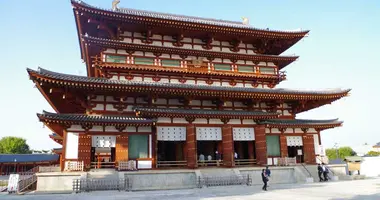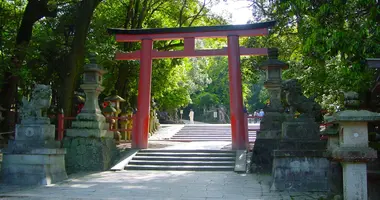Hasedera Temple Nara
- The Way to the Temple
- Touring the Temple
- Hasedera Temple History
- Hasedera Seasons and Events
- Access - Getting To Nara
- Japan Temples & Shrines
Nara Temples: Hasedera Temple 長谷寺, 桜井市, 奈良
Johannes Schonherr
Hasedera Temple is a sprawling temple complex today serving as the main temple of the Buzan sect of Shingon Buddhism.
Hasedera Temple is located on a wooded hillside overlooking the valley of the Hase River in Sakurai city in the center of Nara Prefecture, a little south of Nara city. Besides of its stunning location, sophisticated buildings and its sacral artistic treasures, Hasedera draws visitors throughout the year for its floral beauty.

Pagoda, Hasedera Temple, Nara

Staircase Corridor, Hasedera Temple, Nara
The Way to the Temple
Walking out of the small Hasedera Station on the Kintetsu Osaka Line and through the quiet neighborhood adjoining it, you feel like walking through rustic, old, rural Japan - which is exactly what you are doing here. The streets are narrow and sometimes so steep that they have been turned into stairways.
Things get livelier once you arrive down in the valley and cross the bridge over the Hase River. Here, you enter the main road to the temple. The road follows the Hase River and is lined by vintage, wooden buildings. Soon, the main hall of the temple comes into view, high up on the side of Mount O-Hatsuse. Hatsuse is the old name of the area.
Little side streets to the right lead to small red bridges over the river, then continuing as ancient stairways to small forest shrines.
The closer you get to the temple, the more crowded the street gets. Shops and restaurants hawk their wares. Make sure to pick up a few kusamochi (sweet rice balls laced with Japanese mugwort leaves) from one of the roadside mochi stores. They are an excellent traditional snack and their taste fits the historic environs perfectly.

Eleven-Faced Kannon Statue, Hasedera Temple, Nara

Hasedera Temple, Nara
Touring the Temple
The first temple building you will encounter is the Souketsuke, a small building to the right of the steps leading up to the temple gate. It serves today as sort of rest place for visitors, drinks are provided from vending machines.
A deity named Akiba Gongen is enshrined at the Souketsuke, a god protecting against fires. An important guardian for Hasedera Temple, which has burned down repeatedly in its long history.
Walk up the steps, buy your admission ticket and enter the actual temple grounds through the impressive Niomon Gate. The calligraphy of the characters spelling out "Hasedera" on the gate was composed by Emperor Go-Yozei, who reigned from 1586 to 1611. The current gate dates, however, from 1894 when large reconstruction work was done to renovate the temple.
Right behind the Niomon Gate begins the Staircase Corridor, a roofed stairway consisting of three sections and leading all the way up to the Main Hall. The Staircase Corridor dates back to the year 1039 when the head priest of a nearby shrine had it built to express his gratitude for a child's recovery from a severe illness. The Staircase Corridor is, all in all, about 200m long and has 399 steps. It also underwent reconstruction in 1894, the lanterns lighting it in the evening date from that time.
The Main Hall is, as the name suggests, the heart of the temple. It houses the main ceremonial stages as well as a number of sophisticated Buddha statues.

Fall Colors, Hasedera Temple, Nara
The most prominent of those statues is the Eleven-Faced Kannon, an image depicting Kannon, the Goddess of Mercy and her 11 faces. The original statue of Hase Kannon is said to have been carved out of a camphor tree in the year 727 within just three days. The current statue was crafted in the year 1538. It is about 10m high and serves as the model for all Hase Kannon statues in Japan (including the famous Kannon statue at the Hasedera Temple in Kamakura which is closely affiliated with this temple.)
While you can always see the Kannon statue as a casual visitor from a distance, in the spring (February to June) and in the autumn season (late October to early December) you will be able to touch and kiss the statue. You will have to pay a fee of 1000 yen for that privilege and a monk will lead you personally to the statue and assist you in the special rites, such a close encounter with the Kannon requires.
A large veranda outside the Main Hall allows for a spectacular view over the Hase Valley and the surrounding hills.
Plenty of smaller historic temple buildings dot the hillside, each worth a visit. You can spend hours walking around the temple grounds and will still discover new sights.
One sight not to be missed is the Five-Storied Pagoda, located a few minutes' walk from the Main Hall. Though erected as recently as 1954, it is a wonderful example of a traditional Japanese-style pagoda. It was the first pagoda erected in Japan after World War II and it has been named Showa Pagoda after the period it was built in.
The two storey building houses other historic treasures including statues, paintings, ritual objects and wooden beams from earlier buildings on the site. The Five Storied Pagoda is surrounded by rare Buddhist statues from India including three from ancient Gandhara, in what is now present-day Afghanistan and Pakistan.

Hasedera Temple in Sakura (Cherry Blossom) Season, Nara
Hasedera Temple History
The original Hasedera was founded in 686 A.D. when a Buddhist priest named Domyo enshrined a bronze plaque carved with a three-storied pagoda, two sitting Buddhas and a prayer for the health of Emperor Temmu in a then newly erected building at the current location of the Moto Hasedera Temple (Original Hasedera Temple), a short walk from the Main Hall. The bronze plaque, known as Douban Hokke Sessou Zu, is today listed as a National Treasure of Japan.
In the year 727, the first large statue of the Eleven-Faced Kannon was enshrined here by a priest named Tokudo Shonin. Tokudo Shonin was a fervent worshipper of Kannon, the Goddess of Mercy, and he started the pilgrimage network of 33 sites in Kansai sacred to Kannon. Subsequently, the Hase Kannon faith spread throughout all of Japan.
During the Heian Period (794-1185), Hasedera Temple was a favorite site to visit for the Kyoto based court aristocracy even though getting to the temple from Kyoto meant an arduous trek. Hasedera is featured in some of the most famous literary works of the period.
Most famous among them are the literary classics Genji Monogatari (The Tale of Genji), written by noblewoman Murasaki Shikibu in the early 11th century, and the Pillow Book (Makura no Soshi) written by court lady Sei Shonagon towards the end of the 10th century and completed in 1002.
Upon the arrival of the Buddhist priest Sennyo, a fierce Buddhist preacher, in 1588, Hasedera became the main temple of the Buzan sect of Shingon Buddhism, a position it holds to this day.

Hasedera Temple Pagoda, Nara
Hasedera Seasons and Events
The first big event at Hasedera during the year is New Year's Eve. In a ceremony called Kannon Mandoe (Kannon 10,000 Lights Ceremony) the entire Staircase Corridor is lit up with a line of thousands of lanterns. Expect big crowds.
In the evenings of January 1st, 2nd and 3rd, the lanterns will also be lit up from 5pm to 8pm. The crowds might be considerably smaller on those evenings.
Sakura: From late March to early April, the cherry trees of the temple will blossom, providing an exquisite scenery.
Chinese Peony Season: From mid-April to early May, the 7,000 Chinese peonies planted alongside the Stairway Corridor are in bloom. This is one of the main visiting seasons for the temple.
Momiji Festival: Momiji are Japanese maple trees turning bright red in autumn. The temple celebrates their autumn colors from mid-October to early December. However, don't expect to see their full autumn colors before mid to late November.
Hasedera Food
The many traditional restaurants on the road leading to / from the temple are careful to provide dishes fitting each season. During the fall season, they serve excellent matsutake rice. Matsutake are a highly prized Japanese mushroom variety.

Hasedera Temple, Nara
Access - how to get to Hasedera
Train
Take the Osaka Kintetsu Line from Osaka Uehommachi Station or Tsuruhashi Station (both in Osaka) to Hasedera Station (about a 1 hour train trip). From Hasedera Station, the temple is about a 15 minute walk or a five minute taxi ride.
From Kyoto Station in Kyoto take a Kintetsu Limited Express to Yamatoyagi Station (47 minutes), then change to a Kintetsu Osaka Line Semi-Express train for Haibara.
From JR Nara Station ride a JR Manyo Mahoroba Line train for Takada to Sakurai Station and then change to a Kintetsu Osaka Line Semi-Express train for Haibara and alight at Hasedera Station.
From Kintetsu Nara Station take any train to Yamato-Saidaiji Station, then a train to Yamatoyagi, then change to a Kintetsu Osaka Line Semi-Express train for Haibara getting off at Hasedera (15 minutes).
Hasedera Temple (in Japanese)
731-1 Hase, Sakurai
Nara Prefecture, 633-0112
Tel: 0744 47 7001
An English-language temple guide brochure is available for download on the website.
Hours: From April to September: 8.30 am to 5 pm
March, October, November: 9 am to 5 pm
December to February: 9 am to 4.30 pm
Admission: Adult 500 yen, child 250 yen
Hasedera Temple on google maps

Hasedera Temple, Nara, Nara Prefecture

Hasedera Temple, Nara, Nara Prefecture
Book Hotel Accommodation in Nara
Books on Japanese Culture
Hasedera Temple is located on a wooded hillside overlooking the valley of the Hase River in Sakurai city in the center of Nara Prefecture.
















